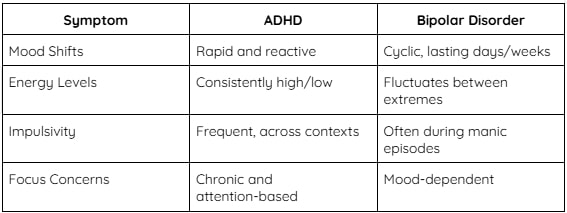
Amaha / / / Hidden Signs and Symptoms of ADHD in Men and Women
ARTICLE | 6 MINS READ
Hidden Signs and Symptoms of ADHD in Men and Women
Published on
11th Jun 2025

Dr Soumya Parameshwaran
MD Psychiatry

Feeling constantly distracted? Struggling to focus, remember, or sit still?
You’re not alone—and it could be more than just stress, laziness or a busy schedule.
Attention-Deficit/Hyperactivity Disorder (ADHD) is one of the most common yet misunderstood mental health conditions across age groups and genders.
Take the First Step.
H4: Get clarity. Seek support. Start with awareness.

Think You Might Have ADHD?
Ever wonder if your day-to-day struggles are more than just stress? This ADHD quiz could have the answers.
What is ADHD?
Akanksha Nair, Senior Psychologist at Amaha, explains, “ADHD (Attention-Deficit/Hyperactivity Disorder) is a neurobiological disorder that impacts the brain's executive functions like attention, concentration, impulse control, and organisation. It initially occurs during childhood but may not be diagnosed until very much into adult life.
ADHD is a very prevalent mental health condition in India but often ignored or it remains hidden. There are more than 10 Million cases per year in India.
The three main types of ADHD are:
- Inattentive type
- Hyperactive-Impulsive type
- Combined type
While commonly associated with children and hyperactivity, in adults, in women, and even cross-culturally, ADHD manifests differently, which explains why ADHD is often misdiagnosed or overlooked.
Want to learn about different types of ADHD?
[Read more about types of ADHD]
Signs and Symptoms of ADHD
ADHD is not a one-size-fits-all disorder. Signs vary based on age, gender, phase of life, and even culture.
In Women
- Forgetfulness and disorganisation in the long term
- Emotional sensitivity and overstimulation
- Inability to sustain attention when there are distracting stimuli around
- Masking or overcompensating and developing burnout
- Anxiety or mood swings are often misdiagnosed as other illnesses
In Men
- Restlessness and impulsivity
- Having trouble with the completion of tasks
- Short temper or anger outbursts
- Trouble with time management
- Risk-taking behavior
During Pregnancy
- Decrease in attention and executive function due to hormonal fluctuations
- Increased anxiety and emotional dysregulation
- Forgetfulness or brain fog
- Difficulty with following prenatal care regimens
In Children
- Difficulty following instructions
- Easily distracted and forgetful
- Too much talking or restlessness
- Difficulty picking up on social cues and patience
- Difficulty sitting quietly or remaining focused in class
In Teens
- Academic underachievement in the face of potential
- Irritability, mood swings
- Sleep disturbance
- Difficulty prioritising or sequencing tasks
- Risk of low self-esteem and peer conflict
In the Indian Cultural Context
ADHD is misunderstood in India through a cultural definition that obscures the distinction between hyperactivity and naughtiness and inattention and laziness. Fidgety or distractible children tend to be dismissed as "naughty" rather than being brought for clinical evaluation. The cultural pressure to perform well at school has the additional effect of hiding symptoms of illness; if the child is performing well at school, his/her inner distress might be overlooked. In addition, the stigma of mental illness ensures that families wait until too late to get professional help for fear of being stigmatised or rejected. There is also immense pressure to conform, to keep quiet, be obedient and high-achieving, and this leads girls and young women, especially, to internalise their symptoms and self-destruct quietly. As a result, ADHD in India is often underdiagnosed, misdiagnosed, or even overlooked.
Hidden Signs of ADHD
Kinnari Chattopadhyay, Senior Psychologist at Amaha, explains, “Not all signs of ADHD are loud or obvious. In many people, especially adults and women, ADHD can manifest in ways that are quiet, internal, and easily mistaken for personality flaws, mood issues, or simply “not trying hard enough.” For instance, while we often associate ADHD with distraction, many individuals experience the opposite: hyperfocus. This intense absorption in a task can make everything else disappear, appointments, hunger cues, even time itself. It might look like passion or dedication, but it often leads to burnout, neglect of other responsibilities, or guilt when the focus breaks.”
Emotional overwhelm is another frequently misunderstood sign. You may find yourself deeply affected by criticism, feeling crushed by even the smallest hint of disapproval. This sensitivity, known as rejection-sensitive dysphoria, can lead to mood swings or emotional shutdowns that mimic anxiety or depression. Other signs are more practical but just as disruptive: a chronic inability to start tasks despite knowing their importance, struggling to estimate how long things take (time blindness), or constantly feeling "behind" in life. Even sensory sensitivities—like being easily overwhelmed by noise, bright lights, or chaotic environments—can be part of the ADHD picture. These signs don’t always look like what we traditionally associate with the disorder, which is why ADHD so often hides in plain sight.
Bipolar Disorder vs ADHD: Key Differences
Both conditions share overlapping traits—like impulsivity and emotional swings—but differ in nature and management.

Causes and Prognosis
What causes ADHD?
ADHD is not due to poor parenting or a lack of motivation, although these are prevalent myths. It's related to:
- Genetics (family history of ADHD or other mental illness)
- Neurodevelopmental delays
- Prenatal exposures (e.g., smoking, alcohol)
- Low birth weight or prematurity
- Brain structure/function differences
Prognosis
ADHD is highly treatable when properly diagnosed and treated. Most individuals live successful, fulfilling lives when their condition is properly diagnosed and treated.
How is ADHD Diagnosed?
Diagnosis involves:
- Clinical interviews
- Behavioural questionnaires
- History taking (school report, parental return)
- Rule-out of other disorders (e.g., anxiety, depression, bipolar)
H4: Dr Ahmed Reshamvala, Psychiatrist at Amaha, says, “ADHD can't be diagnosed by a single test. Instead, experts utilise standardised screening tools and observational data.”
Treatment of ADHD
ADHD is best managed with a multi-modal protocol, age- and lifestyle-specific.
1. Medication
- Stimulants (e.g., methylphenidate)
- Non-stimulants (in patients with comorbid disease or sensitivity)
2. Therapy
- Cognitive Behavioural Therapy (CBT)
- Executive Function Coaching
- Parent Management Training (for children)
3. Lifestyle Support
- ADHD-friendly habits and aids (timetables, reminder charts)
- Sleep and diet management
- Mindfulness and grounding strategies
How ADHD Affects You
Physical Effect
- Disruptions in sleep
- Brain exhaustion and fatigue
- Increased risk of accidents with impulsivity
Emotional Effect
- Burnout and chronic stress
- Low self-esteem
- Guilt or shame over failed expectations
- Emotional dysregulation
For Caregivers and Loved Ones
Support can be the difference-maker. Here's how to assist
Assisting someone with ADHD—your child, spouse, brother, or friend—is gratifying and infuriating. It starts by letting go of assumptions and embracing patience over frustration. ADHD is not the result of laziness or lack of discipline—it's a neurodevelopmental disorder that affects the way one perceives the world.
It's understanding the difference that it all comes down to. Learn about ADHD so answers come from knowledge and not from frustration. Instead of offering correction, promote professional intervention—therapy, testing, and orderly care can be a game-changer. In the house, simple aids such as visual reminders, calendars, or task division into steps can make sense without getting your loved one rattled.
Do most of all pay attention and enjoy the small victories: being ready on time, having a task done, and asking for help. These small victories build confidence and trust and let them know they are not doing this by themselves. Your non-judgmental support might become an impetus for healing and growth.
Taking care of someone with ADHD?
[Subscribe to our Caregiver Community]

Need Help Managing ADHD?
You're not alone in this. Talk with a mental health expert who understands and can help you take the next step.
Frequently Asked Questions:
1. How do I know if I'm ADHD?
You might wonder, “Am I just forgetful, or is it something more?” ADHD symptoms often show up as trouble focusing, impulsivity, or feeling restless. Adults and kids alike can experience inattentiveness, hyperactivity, or impulsivity. For example, difficulty finishing tasks, losing things often, or feeling mentally foggy could be signs. In India, awareness is growing, but many still overlook these signs. A proper diagnosis usually involves a clinical evaluation by a mental health professional who looks at your history and symptoms closely
2. What are the common brain fog signs and symptoms linked to ADHD?
Brain fog in ADHD feels like your mind is wrapped in cotton wool — forgetfulness, trouble thinking clearly, and mental fatigue. You might find it hard to follow conversations or complete simple tasks. It’s not just laziness or tiredness; it’s a real cognitive hurdle that can make daily life challenging and dysfunctional.
3. Do I have ADHD or depression?
This is a tricky one because symptoms overlap — like difficulty concentrating or feeling low. But here’s the thing: ADHD symptoms usually depend on the situation and can improve with a stimulating environment. Depression feels more like a deep, persistent low mood that isn’t tied to external events. Also, depression often brings changes in appetite and sleep, while ADHD involves more restlessness and impulsivity.
4. How can I tell if it’s ADHD or anxiety?
Both can cause restlessness and trouble focusing, but anxiety often comes with excessive worry and physical symptoms like a racing heart. ADHD’s inattentiveness and impulsivity are more about brain regulation issues than fear or worry. Sometimes, they coexist, making professional assessment crucial.
5. What does untreated ADHD look like?
Untreated ADHD can lead to chronic issues — poor academic or job performance, strained relationships, low self-esteem, and mental health struggles like anxiety or depression. In India, stigma sometimes delays diagnosis, worsening outcomes. Early therapy and support can change the game entirely
6. How do ADHD symptoms differ between men and women in India?
Women often internalise symptoms - daydreaming instead of disrupting. They develop masking strategies like excessive lists while struggling internally with organisation and cultural expectations.
7. Can ADHD be diagnosed and treated effectively in India?
Yes! Major cities have qualified professionals. Treatment includes medication, therapy, and lifestyle changes. Find specialists who understand adult ADHD, not just childhood hyperactivity. Diagnosis involves a detailed clinical evaluation by psychiatrists or psychologists, self-report scales, and sometimes input from family or colleagues. Psychological tests help rule out other conditions like anxiety or depression. The process follows international standards like ICD-11 but tailored to Indian contexts and cultural nuances.
8. Should I be concerned about ADHD during pregnancy?
Work with both psychiatrist and obstetrician for safe medication management. Don't stop treatment suddenly. Many women successfully manage ADHD during pregnancy with proper care.
Was This Article Helpful?
Yes
No



Build a good life for yourself
with Amaha
Best App
for Good
on Google Play India

Amaha is equipped to provide care and support for individuals experiencing severe psychological distress, including complex psychiatric disorders and other complex conditions. For those in need of more intensive care and daily support, we are launching an in-patient care facility in Bengaluru soon.
If you or someone you know is experiencing at-risk behaviors or safety concerns, or any other life-threatening crisis or critical mental health situation, contact a helpline or go to the nearest hospital or emergency room. Having a close family member or friend with you for support can be invaluable during this time.
For emergency mental health support, please call the national Tele MANAS helpline at 1-800 891 4416.